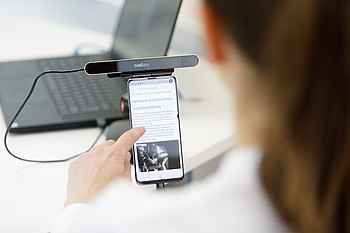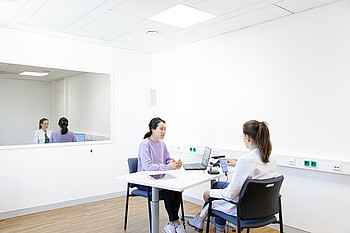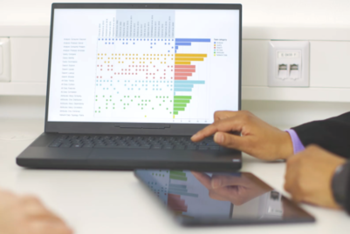You are here
Content
Eye-tracking method

Eye-tracking is a technique for monitoring and analyzing the movement of a person's eyes as they interact with stimuli such as images, videos, or user interfaces. This method uses specialized hardware and software to precisely track the direction and duration of eye fixations and movements.
In usability studies, the eye-tracking method enables researchers to understand how users interact visually with user interfaces, websites, or products by revealing patterns of attention, areas of interest, and navigation strategies. By capturing and analyzing eye movement data, researchers can gain valuable insights into user behavior, attention processes, and cognitive workload, which ultimately supports the design and optimization of user interfaces and digital products.
Qualitative and quantitative approaches

Qualitative and quantitative approaches such as interviews and questionnaires offer great advantages for usability studies. Qualitative methods such as interviews allow for an in-depth exploration of user experiences, preferences, and motivations, providing diverse, nuanced insights.
On the other hand, quantitative techniques such as questionnaires allow researchers to collect structured data from a large sample, facilitating statistical analysis and generalization of results. By combining both approaches, usability researchers can gather comprehensive data to inform design decisions, identify usability issues, and effectively optimize user experiences.
Formative/summative evaluations

Formative evaluation in the field of usability of medical devices is about assessing the user-friendliness of a product during the development phases. The aim is to identify usability problems at an early stage so that iterative improvements can be made to the design. This process usually involves conducting usability tests with potential representative users. The feedback can be used to gain insights that can then be used to improve the design.
Summative evaluation, on the other hand, is carried out as soon as the respective product is nearing completion or has already been completed. The focus of this evaluation is the overall assessment of the user-friendliness and safety of the product based on predefined criteria or standards. The summative evaluation often includes formal testing, including a usability test and validation studies. This ensures that the product meets the legal requirements and the needs of the users
Data analysis

We offer a comprehensive approach to analyzing data and presenting results from formative and summative evaluations. Our methodology involves careful examination and interpretation of the data collected to assess the usability and effectiveness of the product.
Learn how we summarize the results in a clear and concise manner using charts, graphs, and written reports to provide actionable insights and recommendations for improvement.
Context Column
Biomedical Informatics
Medical Faculty Mannheim
Heidelberg University
Theodor Kutzer-Ufer 1-3
68167 Mannheim
Contact

Preetha Moorthy, M.Sc.
phone +49 621 383-8511/-8512
preetha.moorthy@medma.uni-heidelberg.de
